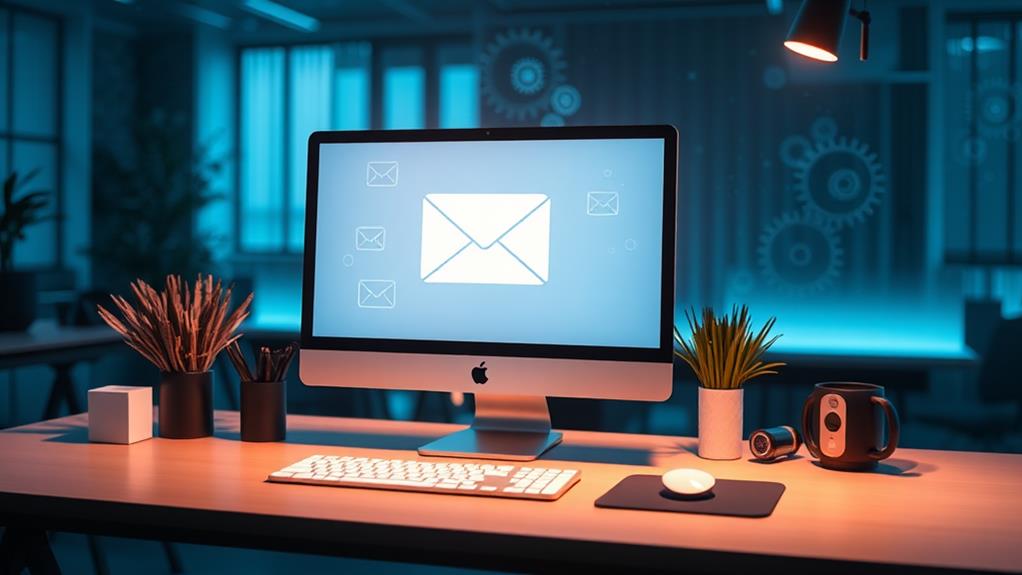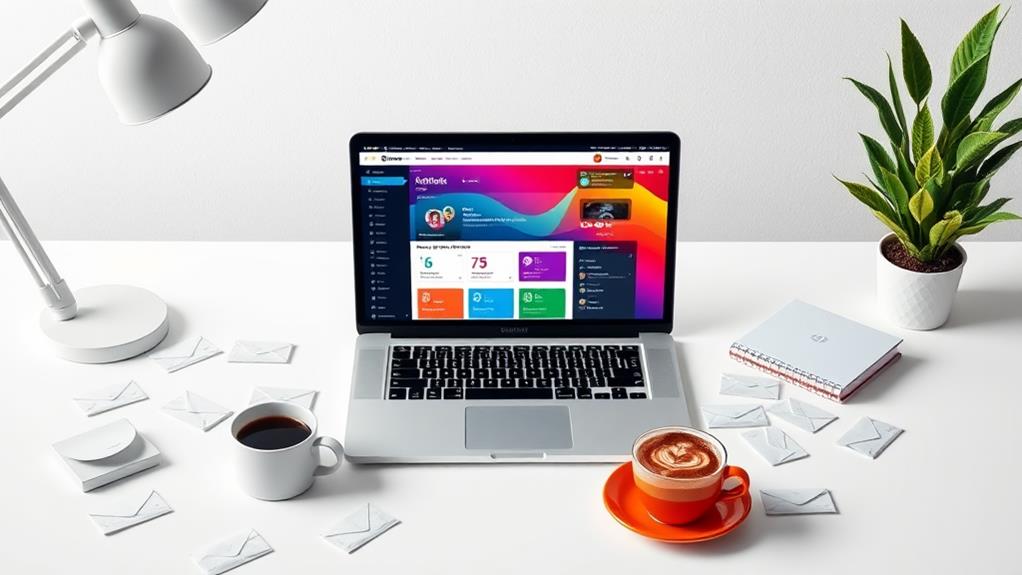Email marketing tools are essential for retaining customers, offering an ROI of $42 for every $1 spent. With personalized strategies, such as dynamic content and segmentation, businesses can achieve a 760% increase in revenue. Welcome emails with a 50% open rate lay the foundation, while cart recovery emails reclaim up to 14% of lost sales. Thoughtful timing and frequency—such as sending emails on Tuesdays and Thursdays—enhance engagement by 20%. Furthermore, automation guarantees every message is timely and relevant, meeting consumer expectations. Thorough analysis and adjustments based on performance metrics solidify these efforts, guaranteeing successful retention outcomes await.
Key Takeaways
- Personalize emails using dynamic content and behavioral triggers to enhance engagement and retention.
- Utilize segmentation to tailor content and timing, improving relevance and customer satisfaction.
- Leverage automated emails like welcome and re-engagement campaigns to boost engagement and recover lost sales.
- Monitor open rates and click-through rates to refine strategies and improve campaign effectiveness.
- Integrate loyalty programs into emails to encourage repeat purchases and foster customer loyalty.
Understanding Customer Retention
Grasping the concept of customer retention is pivotal for any business aiming for sustainable growth. Retention metrics reveal that retaining existing customers is considerably cost-effective, ranging from 5 to 25 times cheaper than acquiring new ones. This financial efficiency underscores the strategic importance of fostering customer loyalty.
Studies indicate that a mere 5% increase in customer retention can lead to profit surges between 25% to 95%, elucidating the profound impact of customer loyalty on a company's bottom line. The value of maintaining relationships with existing clients becomes evident when considering that loyal customers generate an average profit of $39 per purchase. This highlights the necessity of implementing effective retention strategies to enhance the overall customer experience.
By focusing on retention metrics, businesses can achieve higher satisfaction levels and reduce churn rates, and in turn, strengthen customer loyalty. Furthermore, retaining customers does not only bolster profitability but also nurtures brand loyalty. Satisfied customers are more inclined to recommend products, thereby amplifying the brand's reach organically.
Emphasizing customer retention, consequently, emerges as a strategic imperative for businesses aspiring for long-term success and financial stability.
Benefits of Email Marketing
Leveraging email marketing is a potent strategy for enhancing customer retention, which 87% of retailers recognize as their top tool for keeping customers engaged. This approach offers considerable advantages, particularly when coupled with email segmentation and loyalty programs.
The financial benefits are clear, with an average return on investment of $42 for every $1 spent, making it an exceedingly cost-effective method for fostering customer loyalty. Personalized campaigns, enhanced by segmenting your email lists, can meet the expectations of 71% of consumers who desire tailored marketing messages.
The strategic advantages of email marketing in retaining customers include:
- Cost Efficiency: Retaining existing customers through email is considerably cheaper than acquiring new ones, which can be 5 to 7 times more expensive.
- Profitability Impact: According to Bain & Company, a mere 5% improvement in customer retention can boost profits by 25% to 95%.
- Enhanced Engagement: Email segmentation allows for targeted messaging, increasing the likelihood of customer interaction and retention.
- Increased Loyalty: Integrating loyalty programs within email communications can strengthen relationships and encourage repeat patronage.
Types of Retention Emails
To capitalize on the strategic benefits of email marketing for customer retention, understanding the various types of retention emails is essential. One of the most effective types is the welcome email, boasting an impressive 50% open rate. This initial communication establishes a strong connection with new customers, setting the tone for future interactions.
Complementing this are feature announcement emails, which keep customers informed about new product features, showcasing continuous value and maintaining engagement with the brand.
Incentivizing customer loyalty can be effectively managed through promotional emails. By offering discounts and special offers, businesses can notably boost repeat purchases and enhance customer satisfaction.
Additionally, addressing potential lost sales, cart recovery emails prove instrumental. By gently reminding customers of items left in their shopping carts, these emails can recover 3%-14% of sales, prompting customers to complete their purchases.
Lastly, reminder tactics play an essential role in retaining customer interest. Reminder emails serve as timely nudges for important dates, such as subscription renewals or upcoming trials, ensuring customers remain informed and engaged with services.
Strategically deploying these retention emails can enhance customer loyalty and drive sustained business success.
Personalization Techniques
A multitude of personalization techniques in email marketing can greatly amplify customer engagement and retention. By leveraging these techniques, businesses can notably enhance their communication strategies.
Behavioral triggers are a cornerstone in personalization, as they allow marketers to send emails based on specific customer actions, leading to a 26% increase in open rates. This approach guarantees that messages are timely and relevant, capturing the recipient's attention effectively.
Dynamic segmentation takes personalization a step further by categorizing email lists based on customer demographics and purchase history. This strategic segmentation can result in a staggering 760% higher revenue from segmented campaigns compared to non-segmented ones.
The following techniques illustrate the power of personalization:
- Dynamic Content: Incorporating dynamic content that adapts to user data can boost engagement by 50%, guaranteeing information is tailored to individual preferences.
- Personalized Subject Lines: These can achieve a 50% higher open rate by creating a sense of individual attention.
- Product Recommendations: Offering personalized suggestions based on past purchases can drive 300% more conversions.
- Behavioral Triggers: Triggered emails based on customer actions enhance relevance and timely engagement.
Strategic implementation of these techniques can transform email marketing, fostering long-term customer loyalty.
Crafting Engaging Content
Building upon the foundation of personalization techniques, crafting engaging content is vital for capturing and retaining customer interest in email marketing. Personalized emails, utilizing the recipient's name, greatly increase open rates by 26%.
To further enhance engagement, email storytelling should be integrated, offering diverse content formats such as educational resources, promotions, and brand narratives. This strategy not only keeps content fresh but also minimizes customer disengagement.
Subject line strategies are essential, with 47% of recipients opening emails based on the subject line alone. Highlighting benefits or creating urgency within subject lines can dramatically improve open rates.
Additionally, incorporating a clear and singular call-to-action (CTA) guides customers toward desired actions, with emails featuring one CTA seeing a 371% increase in clicks.
Regular testing and optimization of email content are important. A/B testing different layouts, visuals, and messaging can lead to a 49% increase in click-through rates by identifying the most effective variations.
Timing and Frequency Strategy
Mastering the timing and frequency of email campaigns is essential for enhancing customer retention and engagement. Striking the right balance involves understanding the nuances of ideal sending and audience segmentation.
Studies reveal that sending too many emails can cause subscriber fatigue, with 78% of consumers opting out due to excessive messaging. To avoid this, businesses must strategically determine their email frequency based on subscriber preferences.
- Ideal Sending Days: Research indicates that emails dispatched on Tuesdays and Thursdays result in 20% higher engagement rates, making these days perfect for sending out newsletters and promotions.
- Audience Segmentation: Tailor your timing strategy by segmenting your audience based on their engagement levels. Highly engaged users may welcome more frequent updates, whereas less engaged subscribers might prefer less frequent communications.
- A/B Testing: Implement A/B testing to discover peak engagement times. Data shows that emails sent between 10 AM and 2 PM yield superior click-through rates, helping refine your strategy further.
- Performance Monitoring: Regularly assess your campaigns through metrics like open rates and click-through rates. This enables real-time adjustments to enhance both timing and frequency, ultimately improving customer retention.
Leveraging Automation
Having established the importance of timing and frequency in email campaigns, leveraging automation emerges as a strategic advancement to additionally bolster customer retention. Automation strategies enable businesses to deliver highly personalized messages, considerably increasing engagement. Triggered emails, for instance, achieve a 95% higher open rate compared to standard mass emails. By harnessing automation tools, businesses can precisely segment their customer base, ensuring that each segment receives content that resonates with their preferences. This strategic customer segmentation fulfills the 71% expectation for personalized marketing, enhancing retention.
Consider the following table illustrating the impact of automation:
| Automation Type | Open Rate Increase | Sales Recovery |
|---|---|---|
| Triggered Emails | 95% | – |
| Welcome Emails | 50% | – |
| Re-engagement Campaigns | – | 3%-14% |
Automated welcome and onboarding emails, boasting an open rate of around 50%, are pivotal in customer engagement. Additionally, re-engagement campaigns effectively target lapsed customers, utilizing personalized offers to recover 3%-14% of sales from abandoned carts. Automation also extends to feedback surveys post-key interactions, providing actionable insights that enhance satisfaction and loyalty. By strategically implementing these automation strategies, businesses can not only improve customer retention but also demonstrate responsiveness to evolving consumer expectations.
Analyzing Email Performance
To strategically enhance customer retention through email marketing, organizations must focus on tracking open rates and monitoring click-through rates (CTR) as key performance indicators.
Open rates, which typically range from 15% to 25%, reveal the effectiveness of subject lines in capturing reader interest, while CTRs of 2% to 5% provide insights into the email's content quality and call-to-action appeal.
Tracking Open Rates
Although often overlooked, tracking open rates plays a pivotal role in analyzing email performance, serving as a key indicator of audience engagement. Implementing open rate enhancement strategies can noticeably improve the effectiveness of email marketing campaigns.
Industry statistics reveal that open rates typically fluctuate between 15% and 25%, underscoring the necessity for continuous improvement. Subject line experimentation, particularly through A/B testing, is proven to be a potent tactic. Personalized subject lines, for instance, can boost open rates by an average of 26%, demonstrating the power of targeted communication.
Strategically analyzing open rates over time can unearth valuable trends. For example, emails dispatched on Tuesdays and Thursdays consistently achieve superior open rates, guiding marketers in improving their sending schedules.
Additionally, segmenting email lists to address specific customer groups can greatly augment open rates by ensuring content relevance and resonance.
Markdown List:
- A/B Testing: Experiment with subject lines to determine what resonates best with your audience.
- Personalization: Incorporate personal elements to boost open rates by up to 26%.
- Timing: Schedule emails for peak days like Tuesdays and Thursdays for best engagement.
- Segmentation: Target specific groups to increase relevance and improve open rates.
These tactics, grounded in data-driven insights, are instrumental in enhancing customer retention through email marketing.
Monitoring Click-Throughs
Monitoring click-through rates (CTR) stands as a critical element in evaluating the effectiveness of email marketing efforts, serving as a direct measure of how successfully content engages the audience and prompts action.
With average CTRs in the retail sector ranging from 2% to 5%, understanding and optimizing these metrics can greatly impact business outcomes. Click through optimization can lead to impressive results; businesses that enhance their emails to boost click rates can witness up to a 50% increase in sales.
Strategic CTR analysis involves segmenting email lists to discern which customer groups are most responsive, enabling marketers to tailor retention strategies more effectively. This segmentation allows for targeted messaging that resonates with specific audiences, thereby increasing engagement and loyalty.
In addition, A/B testing different email components—such as subject lines, visuals, and calls-to-action—provides actionable insights into which elements drive higher CTRs. This iterative approach guarantees continuous improvement and adaptation in email performance.
Regularly analyzing CTR data over time helps businesses identify emerging trends and refine their strategies, ultimately enhancing customer retention efforts.
Frequently Asked Questions
How Do I Choose the Right Email Marketing Platform for My Business?
Selecting the right email marketing platform involves evaluating email automation capabilities and platform features. Analyze your business needs, customer segmentation, scalability, and integration options. Prioritize platforms offering robust analytics to measure performance and refine strategies effectively.
What Are the Legal Considerations for Email Marketing Campaigns?
When conducting email marketing campaigns, businesses must adhere to consent requirements and establish transparent privacy policies. Compliance with regulations like GDPR or CAN-SPAM Act is critical, ensuring customer trust while strategically enhancing engagement and retention rates.
How Can I Grow My Email Subscriber List Effectively?
To effectively grow your email subscriber list, employ subscriber incentives such as exclusive discounts and valuable content. Strategically utilize list segmentation to target specific audience demographics, maximizing engagement and conversion rates, supported by data-driven analysis and continuous refinement.
What Are the Common Mistakes to Avoid in Email Marketing?
Common mistakes in email marketing include neglecting engaging subject lines and inadequate segmentation strategies. Data indicates personalized content increases open rates by 26%, emphasizing the strategic importance of tailored communication to enhance customer retention and satisfaction.
How Do I Integrate Email Marketing With Other Digital Marketing Strategies?
To effectively integrate email marketing with other digital strategies, utilize email segmentation strategies for targeted messaging and employ automated email workflows to streamline communications. This enhances personalization, drives engagement, and guarantees consistent messaging across multiple platforms, maximizing marketing effectiveness.
Conclusion
In summary, leveraging email marketing tools effectively can greatly enhance customer retention by utilizing data-driven personalization techniques and strategically crafted content. Retention emails, when tailored to customer preferences and behaviors, foster engagement and loyalty. A well-considered timing and frequency strategy, coupled with automation, guarantees consistent and relevant communication. Analyzing email performance metrics provides insights for continuous improvement, aligning marketing efforts with customer needs and expectations. This strategic approach maximizes the potential of email marketing as a powerful retention tool.




